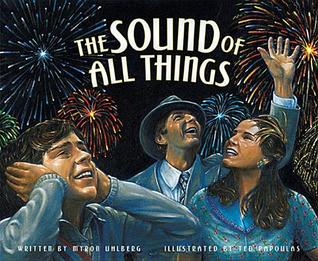The Sound of All Things is an award-winning picture book written by Myron Uhlberg as he remembers, nearly eighty years later, what it was like to be a “hearing” child describing to his deaf parents “the sound of all things.”
Your parents are deaf but you can hear. In this picture book a hearing son describes to his father through sign language all the noise and music that surround them as they enjoy the sights of the amusement park, Coney Island. But how do you explain the roar of a roller coaster or the crash of ocean waves? Both parents sign to their son how sound feels to them: “I feel the wind,” my father signed, “the way I feel your voice when you talk into the palm of my hand.” When the son needs more words he discovers a wealth of language at their library.
Sharing Suggestions:
Try “speaking” in American Sign Language (ASL). You can find explanations and see video examples of the basic 100 signs at http://www.lifeprint.com/. If you live near a college or university where sign-language is taught, invite a student or professor who knows sign language to come to your classroom and demonstrate signing the book The Sound of All Things as the class reads aloud.
As you watch someone signing – or watch a video – observe how American Sign Language is a visual gestural language. That means it is a language that is expressed through the hands and face and is perceived through the eyes. Notice that the person speaking with sign language isn’t just using fingers, hands, and arms. Observe how the whole body is used to communicate – perhaps eyebrows furrow, the head tilts, eyes glance in a certain direction, the person leans closer or farther away. All these visual motions are part of the language!
Think about all the information you learn by the sounds you hear. Go outside. Sit with a notebook. Write down the sounds you hear. Can you tell how close or far away is each sound? Is the source moving closer or farther away? What kind of environmental sounds do you hear? Birds, wind, tree branches, water flowing, rain falling? Children playing a game – what kind of game? People walking by, riding past on a bicycle, skateboard, car?
Think about losing a different sense – what if you were blind instead of deaf? Compare what would be hard about losing sight versus losing hearing. Read Cece Bell’s description of her experience growing up hard-of-hearing. Then read George Mendoza’s description of losing his eyesight but continuing to become an Olympic runner and then an artist. What if you lost the ability to walk? Read Padma Venkatrama’s A Time to Dance which tells the story of a young girl, passionate about dancing, who loses her leg in a car accident. Compare how each type of loss – hearing, sight, mobility) affects one’s daily life, friendships, hobbies, sports, and education.
The Sound of All Things was just recently recognized as an ILA Notable Book for a Global Society.
Related texts:
Bell, Cece. (2014). El Deafo. NYC: Abrams.
Powers, J.L. (2014). Colors of the wind, the story of blind artist and champion runner, George Mendoza. Kentucky: Purple House Press.
Venkatraman, Padma. (2014) A time to dance. NYC: Nancy Paulsen Books.
Stork, Francisco X. (2009). Marcelo in the real world. (Asperger) NYC: Scholastic.
Myron Uhlberg. (2016). The Sound of All Things. Atlanta, Georgia: Peachtree Publishers. 36 pages, 4 – 8 years. Nonfiction/ memoir.